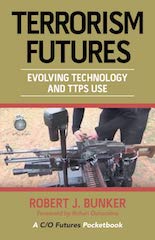terrorism
SWJ Book Review − Power to the People: How Open Technological Innovation is Arming Tomorrow’s Terrorists
About the Author(s)
ISIS or al-Qaeda: Which Looms as the Greater Threat to Global Security?
About the Author(s)
Psychology of the Radical
About the Author(s)
Redefining Terrorism in the 21st Century
About the Author(s)
Combating Terrorism Center at West Point: The Terrorist Lists: An Examination of the U.S. Government’s Counterterrorism Designations Efforts
Full Report: https://ctc.usma.edu/the-terrorist-lists-an-examination-of-the-u-s-governments-counterterrorism-designations-efforts/
By Seth Loertscher, Daniel Milton, Bryan Price, Cynthia Loertscher
From September 2020, but especially relevant with the recent decision to designate the Houthis as a Foreign Terrorist Organization.
https://apnews.com/article/joe-biden-iran-cuba-diplomacy-china-93528aaaab4014ab527609da527e93db
This report examines two sanctioning efforts the U.S. government has employed against terrorist actors: the Foreign Terrorist Organization (FTO) list and the designation of individuals as Specially Designated Global Terrorists (SDGTs) under the authority granted by Executive Order 13224. Although the specific purposes of each of these programs differ from one another, ultimately both represent a non-kinetic approach to counterterrorism that relies on the application of diplomatic and/or financial statecraft.
USIP Publication: 2020 Trends in Terrorism: From ISIS Fragmentation to Lone-Actor Attacks
The Global Terrorism Index points to the need for better data and local insights to inform policy to counter extremism.
By Alastair Reed and Kateira Aryaeinejad
In the past five years, terrorist attacks have declined notably around the globe. While this is certainly good news—particularly in the 20th year of the so-called global war on terror—terrorism remains a pervasive threat. Despite declines in its prevalence, the scale of the challenge posed by terrorism and the violent ideologies that underpin it is still immense and the mechanisms by which to address it remain complex and in need of further coordination on a global scale. What trends did we see in 2020? And how can those trends inform policy to counter violent extremism?
In November 2020, the Institute of Economics and Peace released their annual Global Terrorism Index (GTI), an invaluable resource for understanding the current impact of terrorism around the world. On a subject that provokes much speculation and conjecture, the GTI provides hard empirical data illuminating the actual scale and impact of terrorism worldwide with important implications for identifying ongoing and future terrorism trends, tolls, and threats. The GTI data highlights two key patterns of particular note for informing more proactive and effective policy: the decline and displacement of the Islamic State group in the Middle East and the rise of far-right violence in the West.
Full Article: https://www.usip.org/publications/2021/01/2020-trends-terrorism-isis-fragmentation-lone-actor-attacks
TERRORISM FUTURES: Evolving Technology and TTPs Use
TERRORISM FUTURES: Evolving Technology and TTPs Use
Dr. Robert J. Bunker, Small Wars Journal-El Centro Senior Fellow has just released a new pocketbook—TERRORISM FUTURES: Evolving Technology and TTPs Use examining the future of terrorism with an emphasis on evolving technology and the development of terrorist TTPs embracing that technology.

The Terrorism Futures: Evolving Technology and TTPs Use pocketbook is derived from a series of nine essays written by Dr. Robert J. Bunker between December 2014 and June 2017 for TRENDS Research & Advisory, Abu Dhabi, UAE. With subsequent organizational and website changes at TRENDS a majority of these essays are no longer accessible via the present iteration of the entity's website. In order to preserve this collection of forward-thinking counterterrorism writings, the author has elected to publish them as a C/O Futures pocketbook with the inclusion of new front and back essays and a foreword by Rohan Gunaratna. Technologies and TTPs analyzed include virtual martyrdom, IED drones, disruptive targeting, fifth dimensional battlespace, close to the body bombs, body cavity bombs, counter-optical lasers, homemade firearms, printed firearms, remote controlled firearms, social media bots, AI text generators, AVBIEDs, and FPS/live streaming attacks.
Source: Robert J. Bunker, TERRORISM FUTURES: Evolving Technology and TTPs Use. (A C/O Futures Pocketbook.) Bloomington: XLibris, 2020, https://www.amazon.com/gp/product/1664137815/ref=dbs_a_def_rwt_bibl_vppi_i35.
Indo-Pacific Terrorism, Special Operations, and the Coronavirus
Dr. Zachary Abuza (National War College), COL(r) David Maxwell (Foundation for Defense of Democracies), and Commander Alexander Bein (US Special Operations Command) discussed current terrorism and Special Operations Forces (SOF) dynamics for the Indo-Pacific region in the era of the coronavirus. The webinar was moderated by DKI APCSS Professor Lumpy Lumbaca.
